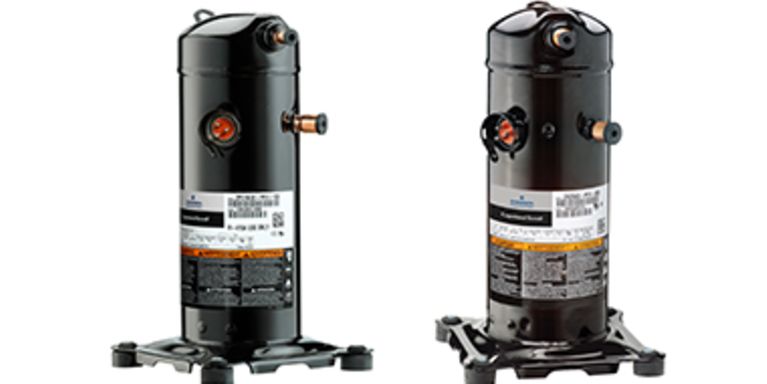EMERSON AE4-1425 Low Temperature ZF**KAE 1-2.5HP Copeland Scroll Refrigeration Compressors

Safety Instructions
Copeland Scroll™ compressors are manufactured according to the latest U.S. and European Safety Standards.Particular emphasis has been placed on the user’s safety. Safety icons are explained below and safety instructions applicable to the products in this bulletin are grouped . These instructions should be retained throughout the lifetime of the compressor. You are strongly advised to follow these safety instructions.
Safety Icon Explanation
DANGER: DANGER indicates a hazardous situation which, if not avoided, will result in death or serious injury.
WARNING: WARNING indicates a hazardous situation which, if not avoided, could result in death or serious injury.
CAUTION:
- CAUTION, used with the safety alert symbol, indicates a hazardous situation which, if not avoided, could result in minor or moderate injury.
- CAUTION, without the safety alert symbol, is used to address practices not related to personal injury.
NOTICE: NOTICE is used to address practices not related to personal injury.
Instructions Pertaining to Risk of Electrical Shock, Fire, or Injury to Persons
WARNING:
ELECTRICAL SHOCK HAZARD
- Disconnect and lock out power before servicing.
- Discharge all capacitors before servicing.
- Use compressor with grounded system only.
- Molded electrical plug must be used when required.
- Refer to original equipment wiring diagrams.
- Electrical connections must be made by qualified electrical personnel.
- Failure to follow these warnings could result in serious personal injury.
PRESSURIZED SYSTEM HAZARD
- System contains refrigerant and oil under pressure.
- Remove refrigerant from both the high and low compressor side before removing compressor.
- Never install a system and leave it unattended when it has no charge, a holding charge, or with the service valves closed without electrically locking out the system.
- Use only approved refrigerants and refrigeration oils.
- Personal safety equipment must be used.
- Failure to follow these warnings could result in serious personal injury.
BURN HAZARD
- Do not touch the compressor until it has cooled down.
- Ensure that materials and wiring do not touch high temperature areas of the compressor.
- Use caution when brazing system components.
- Personal safety equipment must be used.
- Failure to follow these warnings could result in serious personal injury or property damage.
CAUTION: COMPRESSOR HANDLING
- Use the appropriate lifting devices to move compressors.
- Personal safety equipment must be used.
- Failure to follow these warnings could result in personal injury or property damage.
Safety Statements
- Refrigerant compressors must be employed only for their intended use.
- Only qualified and authorized HVAC or refrigeration personnel are permitted to install commission and maintain this equipment.
- Electrical connections must be made by qualified electrical personnel.
- All valid standards and codes for installing, servicing, and maintaining electrical and refrigeration equipment must be observed.
INTRODUCTION
The Low Temperature ZF**KAE Copeland Scroll™ compressor represents the latest generation of compliant scroll technology for the refrigeration industry.
NomenclatureThe refrigeration scroll model numbers include the nominal capacity with R-404A at standard 60HZ ARI rating conditions for low temperature (-25/105ºF). For additional information on this product, please refer to the Online Product Information at Emerson.com/OPI.
Z = ScrollF = Low Temperature Application07K = nominal Capacity (x 1,000 Btu/hr)A = Compressor GenerationE = POE Oil
Operating EnvelopeThe ZF**KAE refrigeration scroll compressor models can be used with a variety of refrigerants depending on the model selected and the lubricant used. (See Table 1) The ZF**KAE models are intended for low temperature refrigeration type duty.Table 1 – Compressor Models and Approved Refrigerants/Lubricants
| Model | HP | Refrigerant | Lubricant |
| ZF03KAE | 1 | R-404A/R-507/R-407A/R-448A/R-449A | POE |
| ZF04KAE | 1.3 | R-404A/R-507/R-407A/R-448A/R-449A | POE |
| ZF05KAE | 1.5 | R-404A/R-507/R-407A/R-448A/R-449A | POE |
| ZF06KAE | 2 | R-404A/R-507/R-407A/R-448A/R-449A | POE |
| ZF07KAE | 2.5 | R-404A/R-507/R-407A/R-448A/R-449A | POE |
The approved operating envelope for these models are such that they are ideally suited for applications such as walk in and reach in freezers. The models and operating envelopes are depicted in Figure 3.
APPLICATION CONSIDERATIONS
AccumulatorsDue to the scrolls’ inherent ability to handle liquid refrigerant in flooded start and defrost cycle operation conditions, accumulators may not be required. An accumulator is required on single compressor systems when the charge limitations exceed those values listed in Table 2. On systems with defrost schemes or transient operations that allow prolonged uncontrolled liquid return to the compressor, an accumulator is required unless a suction header of sufficient volume to prevent liquid migration to the compressor is used.
Table 2 – Charge Limitations
| Model Family | Charge Limits |
| ZF03, 04, 05, 06
07 |
8 lbs. |
Excessive liquid flood back or repeated flooded starts will dilute the oil in the compressor causing inadequate lubrication and bearing wear. Proper system design will minimize liquid flood back, thereby ensuring maximum compressor life
Superheat RequirementsTo assure that liquid refrigerant does not return to the compressor during the running cycle, attention must be given to maintaining proper superheat at the compressor suction inlet. Emerson recommends a minimum of 20°F (11K) superheat, measured on the suction line 6 inches (152mm) from the suction valve inlet, to prevent liquid refrigerant flood back.
Another method to determine if liquid refrigerant is returning to the compressor is to accurately measure the temperature difference between the compressor oil crankcase and the suction line. During continuous operation we recommend that this difference be a minimum of 50°F (27K). This “crankcase differential temperature” requirement supersedes the minimum suction superheat requirement in the last paragraph. To measure oil temperature through the compressor shell, place a thermocouple on the bottom center (not the side) of the compressor shell and insulate from the ambient. During rapid system changes, such as defrost or ice harvest cycles, this temperature difference may drop rapidly for a short period of time. When the crankcase temperature difference falls below the recommended 50°F (27K), our recommendation is the duration should not exceed a maximum (continuous) time period of two minutes and should not go lower than a 25°F (14K) difference.Contact your Emerson representative regarding any exceptions to the above requirements.
Crankcase HeatersCrankcase heaters are required on all ZF**KAE scroll compressors where the system charge exceeds charge limit.The listed crankcase heaters are intended for use only when there is limited access (See Table 3). The heaters are not equipped for use with electrical conduit.Where applicable, electrical safety codes require lead protection, a crankcase heater terminal box should be used. Recommended crankcase heater terminal box and cover kit numbers are listed in Table 4. If there are any questions concerning their application, contact your Emerson representative.
Table 3 – Crankcase Heater
| Model | Part No. | Volts | Watts | Length
(in.) |
|
ZF03, 04, 05, 06 07 |
018-0094-00 | 240 | 40 | 21 |
| 018-0094-01 | 120 | 40 | 21 | |
| 018-0094-03 | 480 | 40 | 21 |
ZF*KAE Low Temperature Liquid InjectionThe low temperature models are provided with an injection port that can be used for liquid injection.Liquid Injection is required when using the ZF*KAE scrolls for liquid injection operation, a discharge temperature control (DTC) valve must be applied.The purpose of the DTC valve is to maintain safe internal operating temperatures.
DTC Valve SpecificationsThe following components are not required, but they are recommended for liquid injection.
- Sight Glass – A sight glass can be installed before the DTC valve to allow for visual inspection for the presence of liquid refrigerant.
- Filter/Drier – A filter/drier can be installed upstream of the injection circuit to avoid the possibility of the DTC screen blockage due to contaminants.
Installation of DTC ValveThe valve bulb must be installed in the top cap thermal well to adequately control scroll temperatures. The valve must be brazed into the injection fitting on the compressorFor Installation Instructions see Appendix A.The capillary tube connecting the valve to the bulb should be positioned such that it does not contact the compressor during operation. Do not bend the capillary tube within 1” (25.4mm) of the valve.The DTC valve comes with an insulating cap. If this additional height from the cap is an issue, the valve cap could be replaced with high temperature insulation. This should be applied to insulate and protect the valves remote bulb assembly. This will reduce the total height requirement by 0.5” (12.7mm) The DTC valve kit part number is 998-0746-00 (liquid line 3/8″ sweat tube, 250°F set point).
Suggested Application Techniques for All Liquid Injection ApplicationsFor the most efficient thermal sensing, spread a thin film of thermal grease around the DTC valve bulb/thermistor before installing into the top cap well. However, for proper functioning of the valve this is not required.
For service purposes, a mechanical ball valve (not provided by Emerson) is also recommended in the liquid line. For the liquid injection system to be effective, a minimum of 5°F subcooled liquid at the at the DTC inlet is required.
NOTE: To ensure adequate temperature control, take care to not damage the DTC valve bulb/thermistor when installing. Damage of DTC valve bulb/thermistor could result in improper injection.
Discharge Line ThermostatIf the system is designed where operation within these guidelines cannot be guaranteed, then a discharge line thermostat is required in the compressor control circuit.When installed approximately 6 inches from the discharge tube outlet, the thermostats have a cut-out setting that will ensure the external discharge line temperature does not exceed the 240°F limit. If a Rotalock service valve is installed on the discharge port connection, the thermostat should be located approximately 5 inches from the valve braze connection.Kits have been set up to include the thermostat, retainer, and installation instructions. These thermostats must be used with ½” O.D. discharge lines to ensure proper thermal transfer and temperature control. They work with either 120 or 240-volt control circuits and are available with or without an alarm circuit capability. See Table 5 for a list of discharge line thermostat kit numbers.
Pressure ControlsBoth high and low-pressure controls are required on all models. See Table 6 for set points.
Table 6 – DTC Valve Kit
| Kit Number | Connection | Setpoint |
| 998-0746-00 | 3/8” SWEAT | 250°F |
Pump Down RecommendationsAll the ZF**KAE scrolls have an internal spring loaded low-leak discharge check valve suitable for pump down application. This valve prevents system pressures from equalizing and pump down can be achieved. However, during laboratory testing, we have observed a potential short cycling condition on the ZF**KAE models. This phenomenon can be attributed to several factors:
- Location of low-pressure control sensor. If it is located right at the suction inlet of the compressor, it will be more sensitive to pressure spikes.
- Actual low-pressure setting. Refer to our recommended setting in Table 6. If the differential pressure setting is too close, this will increase the possibility of short cycling.
- The type of low-pressure control can have an effect on cycling. The encapsulated non-adjustable type is more susceptible to causing excessive cycling due to tolerances.
- If short cycling cannot be avoided, using a 3-minute time delay will limit the cycling of the compressor to an acceptable level.
IPR ValveRefrigeration scroll compressors (1 – 2.5 hp) ZF03,04,05, 06, 07KAE have internal pressure relief valves, which open at a discharge to suction differential pressure of 375 to 450 psi. This action will trip the motor protector and remove the compressor from the line.
Internal Temperature ProtectionRefrigeration scroll compressors (1 – 2.5 hp) ZF03,04,05,06, 07KAE incorporate a thermo disc which is a temperature-sensitive snap disc device located at the muffler plate port. It is designed to open and route hot discharge gas back to the motor protector thus removing the compressor from the line.
Motor ProtectionConventional inherent internal line break motor protection is provided
Oil TypesPolyolester lubricants must be provided if the scroll compressor is to be used with HFC refrigerants. See Form 93-11 for a complete list of all Emerson approved lubricants.
WARNING : POE may cause an allergic skin reaction and must be handled carefully and the proper protective equipment (gloves, eye protection, etc.) must be used when handling POE lubricant. POE must not come into contact with any surface or material that might be harmed by POE, including without limitation, certain polymers (e.g. PVC/ CPVC and polycarbonate). Refer to the Safety Data Sheet (SDS) for further details.
Oil ChargesThe recommended oil charges for these compressors are shown in Table 7.
Table 7 – Pressure Control Settings
| Model Type | Pressure Control | R-404A/R-507 | R-407A/R-448A/R-449A |
| ZF*KAE | Low | 0 psig min | 2 in. Hg min |
| High | 455 psig max | 428 psig max |
Compressor Tubing and MountingCompressor mounting must be selected based on application. Consideration must be given to sound reduction and tubing reliability. Some tubing geometry or ‘shock loops’ may be required to reduce vibration transferred from the compressor to external tubing.
Starting CharacteristicsSingle-phase scroll compressors are designed with permanent split capacitor (PSC) type motors and therefore, will start without the need of start assist devices in most applications. (ZF03KAE-PFV/PFJ Require starting components) However, if low voltage conditions exist at start up, protector trips can result. Therefore, start assist devices (start capacitors and relays) are available to maximize starting characteristics under abnormal conditions. See Table 8 for voltage ranges.
Table 8 – Recommended Oil Charges by Model Family
| Model Family | Initial | Recharge |
| ZF03, 04, 05,
06, 07 |
25 oz | 19 oz |
FusiteFusite pin orientation for single-phase and three- phase refrigeration scroll compressors are shown in Figure 5 and are designed for a molded plug connection.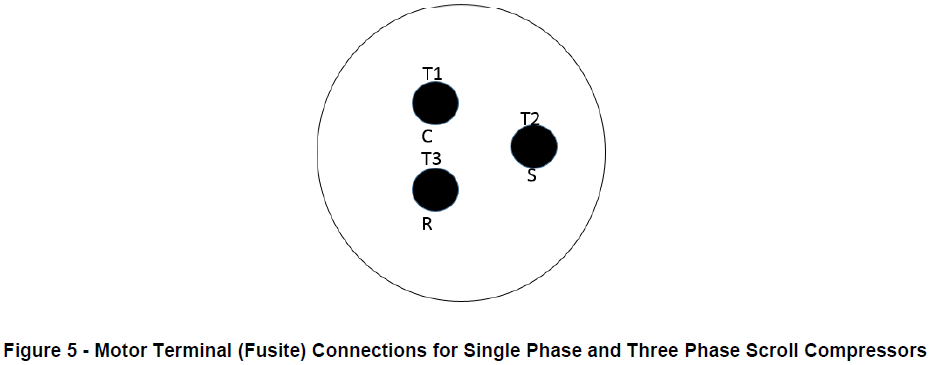

NOTES:
- The above tubing configurations are guidelines to minimize tube stress.
- Follow similar guidelines for discharge tubing and oil return tubing as needed.
- If a run of over 20” is required, intermediate clamps may be necessary.
- Do not hang weights on tubing (e.g. filter drier on suction tubing) except after clamps or close to the header.
- Tube runs of less than 8” are not recommended.
- This dimension should be made as short as possible (e.g. 2” or less) but still insuring a proper braze joint.
- The above tubing recommendations are based on runs with no elbow joints. The use of continuous tubing is preferred.
Shell TemperatureSystem component failure may cause the top shell and discharge line to briefly reach temperatures above 300°F (149°C). Wiring or other materials, which could be damaged by these temperatures, should not come in contact with the shell.
Connection FittingsScroll compressors are provided only with sweat connections. (Consult your representative for details). See section on New Installation for suggestions on how to properly braze these fittings.
Three-Phase Rotation DirectionScroll compressors are directional dependent: i.e., they will compress in one rotational direction only. On single phase compressors, this is not an issue since they will only start and run in the proper direction (except as described under Brief Power Interruptions).Three-phase scrolls, however, will rotate in either direction depending on the power of the phasing, so there is a 50/50 chance of connected power being ‘backwards’. Contractors should be warned of this. Appropriate instructions or notices should be provided by the Original Equipment Manufacturer. Verification of proper rotation can be made by observing that the suction pressure drops and the discharge pressure rises when the compressor is energized. Additionally, if operated in reverse the compressor is noisier and its current draw is substantially reduced compared to tabulated values. Although operation of scroll in reverse direction for brief periods of time is not harmful, continued operation could result in failure.All three-phase compressors are wired identically internally. Once the correct phasing is determined for a specific system or installation, connecting properly phased power leads to the same Fusite terminals will maintain the proper rotation.
Brief Power InterruptionsBrief power interruptions (less than ½ second) may result in powered reverse rotation of single-phase refrigeration scroll compressors. High-pressure discharge gas expands backward through the scrolls at power interruption causing the scroll to orbit in the reverse direction. If power is reapplied while this reversal is occurring, the compressor may continue to run noisily in the reverse direction for several minutes until the compressor internal protector trips. This has no negative effect on durability. When the protector resets, the compressor will start and run normally. Emerson strongly encourages the use of a timer which can sense brief power interruptions and lock the compressor out of operation for two minutes. No time delay is required on three phase models to prevent reverse rotation due to power interruptions.
Deep Vacuum Operation
WARNING : Do not run a refrigeration scroll compressor in a deep vacuum. Failure to heed this advice can result in excessive wear and permanent damage to the compressor.
A low-pressure control is required for protection against deep vacuum operation. See the section on pressure controls for the proper set points. (See Table 6) Scroll compressors (as with any refrigeration compressor) should never be used to evacuate refrigeration or air conditioning systems. See AE24-1105 for proper system evacuation procedures
Table 6 – DTC Valve Kit
| Kit Number | Connection | Setpoint |
| 998-0746-00 | 3/8” SWEAT | 250°F |
ZF**KAE COMPRESSORS IN COPELAND™
CONDENSING UNITS
The new FFAL Copeland condensing units will offer the latest technology utilizing the efficient ZF**KAE scrollproduct along with incorporating the Emerson Electronic Unit Controller (EUC) on all models.
FeaturesAll FFAL condensing units come equipped from the factory with the Electronic Unit Controller. The controller has a minimum low pressure cutout setting of 0 psig. See Table 6 for the recommended pressure control settings based on refrigerant.
Condensing Unit MountingFor 1 – 2.5 H.P. refrigeration scroll condensing unit applications, soft mounts are recommended. See Figure 4.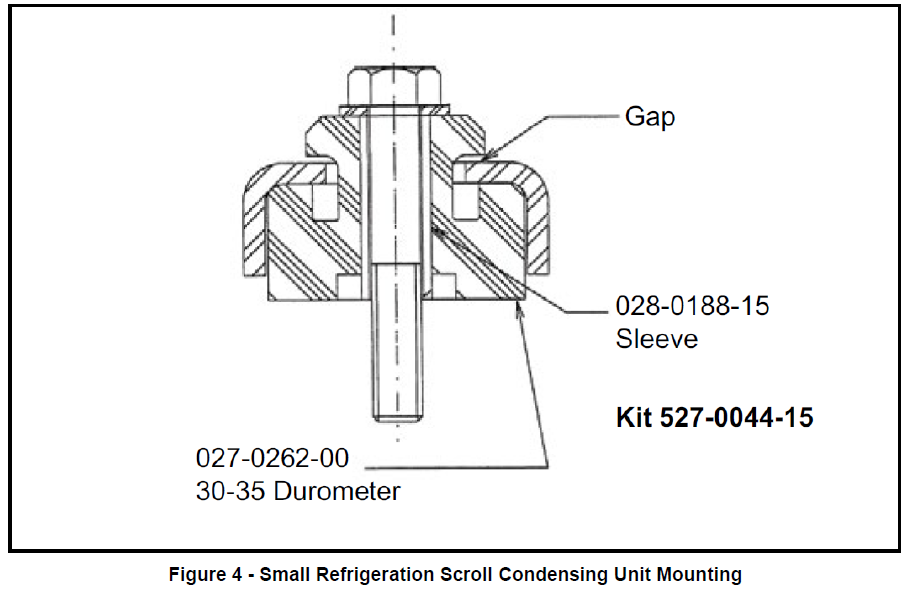 Bump Start ProtectionThe bump start function has been enabled in the EUC so, whenever power is applied or re-applied to the unit the system will energize the compressor for 2 seconds on and 5 seconds, off. This will occur for 3 cycles, and then continuous power will be supplied to the system for normal operation.
Bump Start ProtectionThe bump start function has been enabled in the EUC so, whenever power is applied or re-applied to the unit the system will energize the compressor for 2 seconds on and 5 seconds, off. This will occur for 3 cycles, and then continuous power will be supplied to the system for normal operation.
Brief Power InterruptionsAs part of the EUC control, a two-minute time delay has been programmed into the controller on all condensing units which will sense a brief power interruption and lock the compressor/unit out of operation for two minutes.
Headmaster Refrigerant Selection InstructionsPlease follow the instructions provided below after the refrigerant selection is made, failure to do so will cause the system to operate outside of its approved compressor operating envelope.
The Headmaster Control Valve has a dual pressure setting feature which allows a choice between two fixed settings; The DS element has an internal spring which is set to maintain the lower setting. The element is then charged with air to obtain the higher setting (180 psig) and the capillary tube is pinched and fused. If the capillary tube is left intact, the valve will maintain a 180 psig setting. If the capillary tube is clipped and fused again, the valve will maintain a 100 psig setting. It is important to fuse the capillary tube tip after clipping to prevent moisture from entering the element.
Tubing Considerations – Proper tube design must be taken into consideration when designing the tubing connecting the scroll to the remaining system. The tubing should provide enough “flexibility” to allow normal starting and stopping of the compressor without exerting excessive stress on the tube joints. In addition, it is desirable to design tubing with a natural frequency away from the normal running frequency of the compressor. Failure to do this can result in tube resonance and unacceptable tubing life. Figure 6 shows examples of acceptable tubing configurations.
CAUTION: These examples are intended only as guidelines to depict the need for flexibility in tube designs. In order, to properly determine if a design is appropriate for a given application, samples should be tested and evaluated for stress under various conditions of use including voltage, frequency, and load fluctuations, and shipping vibration.The guidelines above may be helpful; however, testing should be performed for each system designed.
Rack ApplicationsZF**KAE Compressors are not approved for rack or parallel applications because the compressors do not have sight glasses and cannot be equipped with oil equalization devices.
ASSEMBLY LINE PROCEDURES
Unbrazing System Components
CAUTION: If the refrigerant charge is removed from a scroll unit by bleeding the high side only, it is sometimes possible for the scrolls to seal, preventing pressure equalization through the compressor. This may leave the low side shell and suction line tubing pressurized. If a brazing torch is then applied to the low side, the pressurized refrigerant oil mixture could ignite as it escapes and contacts the brazing flame. It is important to check both the high and low sides with manifold gauges before unbrazing. In the case of an assembly line repair, remove the refrigerant from both the high and low sides.Instructions should be provided in appropriate product literatures and assembly areas.
High Potential (Hipot) TestingMany of the Copeland brand compressors are configured with the motor below the compressor. As a result, when liquid refrigerant is within the compressor shell the motor can be immersed in liquid refrigerant to a greater extent than with compressors with the motor mounted above the compressor. When Copeland brand compressors are Hipot tested and liquid refrigerant is in the shell, they can show higher levels of leakage current than compressors with the motor on top because of the higher electrical conductivity of liquid refrigerant than refrigerant vapor and oil. This phenomenon can occur with any compressor when the motor is immersed in refrigerant. The level of current leakage does not present any safety issue. To lower the current leakage reading, the system should be operated for a brief period of time to redistribute the refrigerant to a more normal configuration and the system Hipot tested again. See bulletin AE4-1294 for Megohm testing recommendations. Under no circumstances should the Hipot or Megohm test be performed while the compressor is under a vacuum.
SERVICE PROCEDURES
Copeland Scroll Functional CheckRefrigeration scroll compressors do not have internal suction valves. It is not necessary to perform functional compressor tests to check how low the compressor will pull suction pressure. This type of test may damage a scroll compressor. The following diagnostic procedure should be used to evaluate whether a Copeland Scroll compressor is functioning properly.
- Verify proper unit voltage.
- Normal motor winding continuity and short to ground checks will determine if the inherent overload motor protector has opened or if an internal short to ground has developed. If the protector has opened, the compressor must cool sufficiently to reset.
- With service gauges connected to suction and discharge pressure fittings, turn on the compressor. If suction pressure falls below normal levels, the system is either low on charge or there is a flow blockage.
- Single-Phase CompressorsIf the suction pressure does not drop and the discharge pressure does not rise to normal levels the compressor is faulty.
- Three-Phase CompressorsIf the suction pressure does not drop and the discharge pressure does not rise, reverse any two of the compressor power leads and reapply power to make sure the compressor was not wired to run in the reverse direction.
The compressor current draw must be compared to published compressor performance curves at the compressor operating conditions (pressures and voltages). Significant deviations (±15%) from published values may indicate a faulty compressor.
Note that the ZF03,04,05,06, 07KAE(TFD, TF5) three phase motors use a modified “Scott-T” connection and don’t have equal resistance on all three windings. Two windings will have equal resistances and the third winding will be lower than the other two. See Figure 1. Carefully compare measured motor resistance values to the two different published resistance values for a given compressor model before replacing the compressor as being defective. Due to the nature, of the Scott-T construction there is an inherent current imbalance in the motors that is much larger than what is seen in a standard 3-phase motor. Effectively you will have two terminals drawing similar currents while the third will draw a higher current. The current draw on the Scott –T motors as shown in the performance data and in the operating envelope (available online at Emerson.com/OPI) comes from the 2 main windings.

New Installation
- The copper-coated steel suction, discharge, and injection tubes on scroll compressors can be brazed in approximately the same manner as any copper tube.
- Recommended brazing material – Any Silfos material is recommended, preferably with a minimum of 5% silver. However, 0% silver is acceptable.
- Use of a dry nitrogen purge to eliminate possibility of carbon buildup on internal tube surfaces is recommended.
- Be sure process tube fitting I.D. and process tube O.D. are clean prior to assembly.
- Apply heat in Area 1. As tube approaches brazing temperature, move torch flame to Area 2. (See Scroll Tube Brazing figure below.)
- Heat Area 2 until braze temperature is attained, moving torch up and down and rotating around tube as necessary to heat tube evenly. Add braze material to the joint while moving torch around circumference.
- After braze material flows around joint, move torch to heat Area 3. This will draw the braze material down into the joint. The time spent heating Area 3 should be minimal.
- As with any brazed joint, overheating may be detrimental to the final result.
Field Service
To disconnect: Recover refrigerant from both the high and low side of the system. Cut tubing near compressor.
To reconnect:
- Recommended brazing materials – Silfos with minimum 5% silver or silver braze material with flux.
- Reinsert tubing fitting.
- Heat tube uniformly in Area 1, moving slowly to Area 2. When joint reaches brazing temperature, apply brazing material. (See Figure 2)
- Heat joint uniformly around the circumference to flow braze material completely around the joint.
- Slowly move torch in Area 3 to draw braze material into the joint. Do not overheat joint.
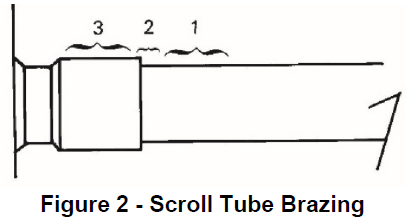
General Guidelines and More Information
For general Copeland Scroll compressor please log in to Online Product Information at Emerson.com/OPI, refer to the Application Engineering bulletins listed below, or contact your Application Engineer.
| Form 93-11 | Refrigerants and lubricants approved for use in Copeland™ compressors |
| AE4-1294 | Megohm Values of Copeland™ Compressors |
| AE24-1105 | Principles of Cleaning
Refrigeration Systems |
Installation Instructions
ZF03/04/05/07KAE R404A, R448A, R449A, R407A/C/F ApplicationsPlease see all the parts before assembly in fig. 1
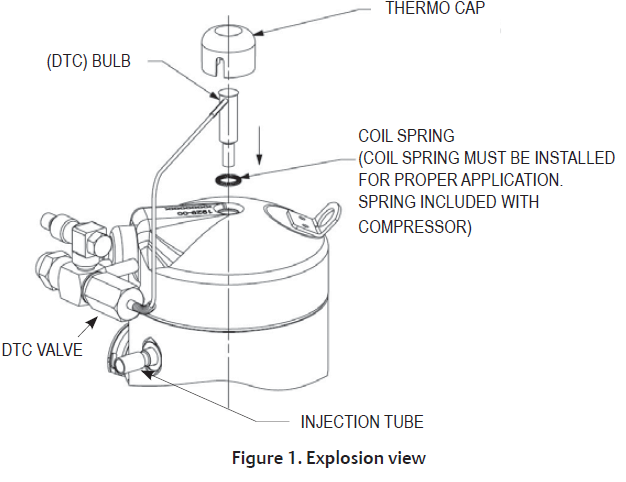
DTC valve assemblyConnect Discharge Temperature Control (DTC) valve to injection fitting.a. DTC valve should bottom out in injection fitting. The DTC valve should be installed in a horizontal orientation.Please see the assembly in Figure 2.
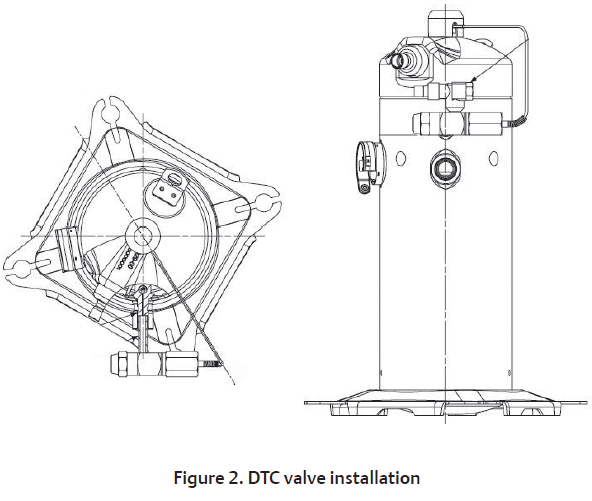
Compressor Brazing Procedure
IMPORTANTPossible blockage! Compressor overheating!Recommend maintaining flow of oxygen-free nitrogen through the system at very low pressure during brazing.Nitrogen displaces the air and prevents the formation of copper oxides in the system. If allowed to form, the copper oxide material can later be swept through the system and block screens such as those protecting capillary tubes, thermal expansion valves, and accumulator oil return holes.
Contamination or moisture! Bearing failure! Do not remove the plugs until the compressor is set into the unit.This minimize any entry of contaminants and moisture.Copeland Scroll Compressors have copper-plated steel suction, discharge, and injection tubes. These tubes are far more robust and less prone to leaks than copper tubes. Due to the different thermal properties of steel and copper, brazing procedures may have to be changed from those commonly used.Figure 3 shows the proper procedure for brazing the DTC valve to a scroll compressor.
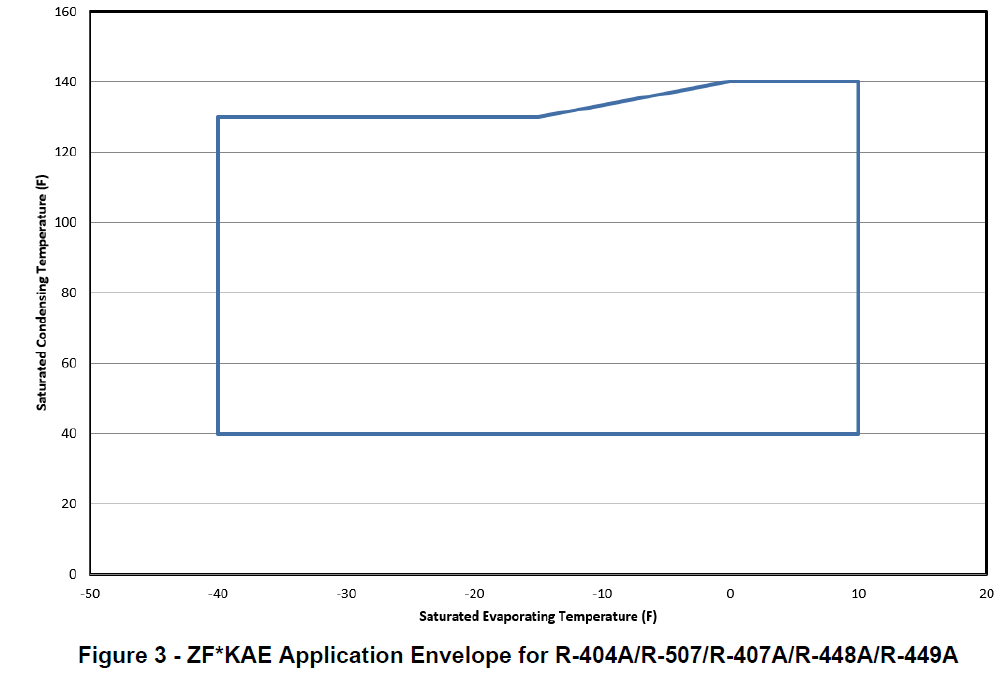
- The copper-coated steel tubes on scroll compressors can be brazed in approximately the same manner as any copper tube.
- Recommended brazing materials: any silfos material is recommended, preferably with a minimum of 5% silver. However, 0% silver is acceptable.
- Be sure tube fitting inner diameter and tube outer diameter are clean prior to assembly.
- Prior to brazing, apply wet rag or any other suitable heat protection to valve body. Overheating of valve body may cause damage to valve.
- Using a double-tipped torch, apply heat in area 1.
- As the tube approaches brazing temperature, move the torch flame to area 2.
- Heat area 2 until braze temperature is attained, moving the torch up and down and rotating around the tube as necessary to heat the tube evenly. Add braze material to the joint while moving the torch around the joint to flow braze material around the circumference.
- After the braze material flows around the joint, move the torch to heat area 3. This will draw the braze material down into the joint. The time spent heating area 3 should be minimal.
- As with any brazed joint, overheating may be detrimental to the final result.
NOTE: Since the injection tubing design of the ZF*KA compressors includes some O-rings, a wet rag or any other suitable heat protection must be used when brazing the injection line to the compressor.

Verify the coil spring is seated in the thermostat tube groove area (see Figure 5) on the top of the compressor. (The spring is required for proper DTC valve installation)
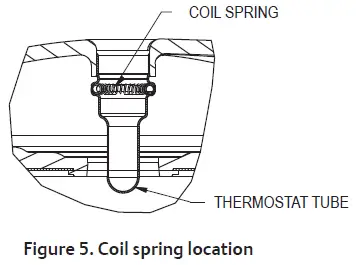
Spread a thin film of thermal grease around DTC bulb. Press DTC bulb into thermostat tube on top of the compressor until the bulb bottoms out in the thermostat tube. (Install by hand, do not use excessive force) Copper tube from the DTC bulb should be approximately [1/8”] off the top of the compressor. Take care and avoid damaging or scratching the bulb. Please see Figure 6.

Snap thermal cap onto DTC bulb on top of the compressor. If there is a need to remove the thermal cap due to height limitations, thermal insulation for the bulb is strongly recommended. Please see figure 6.
2. Maximum operating temperature for valve bulb is limited to [293°F].3. Ensure liquid refrigerant is available in the line feeding DTC valve prior to starting the compressor. Failure to do this will result in damage to the DTC valve and compressor.
DTC Valve Removal
- Close valves to isolate the compressor from the system.
- Evacuate the compressor and ensure no pressure remains.
- To disconnect:Heat joint areas 2 and 3 slowly and uniformly until the braze material softens and the tube can be pulled out of the fitting.
- To reconnect:See Compressor Brazing Procedure. Recommended brazing materials: Silfos with minimum 5% silver or silver braze used on other compressors. Due to the different thermal properties of steel and copper, brazing procedures may have to be changed from those commonly used.

The contents of this publication are presented for informational purposes only and are not to be construed as warranties or guarantees, express or implied, regarding the products or services described herein or their use or applicability. Emerson Climate Technologies, Inc. and/or its affiliates (collectively “Emerson”), as applicable, reserve the right to modify the design or specifications of such products at any time without notice. Emerson does not assume responsibility for the selection, use or maintenance of any product. Responsibility for proper selection, use and maintenance of any Emerson product remains solely with the purchaser or end user.
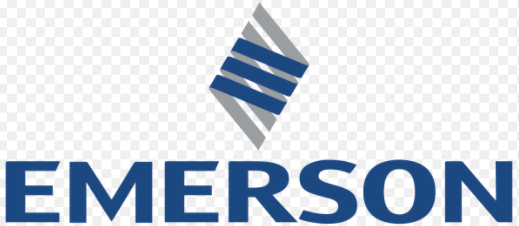
References
[xyz-ips snippet=”download-snippet”]

